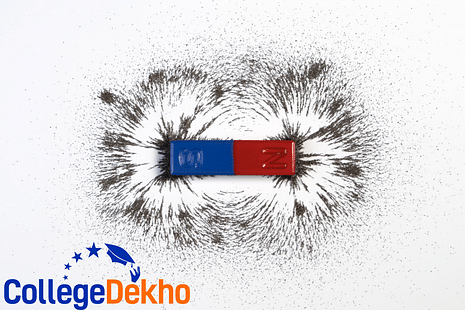KCET Magnetism and Matter Topics 2025 include Bar Magnet, Magnetism & Gauss’s Law, Magnetism & Magnetic Intensity, etc. Magnetism and Matter holds a weightage of 3% to 4% in the KCET exam. Check the complete details related to KCET Magnetism and Matter topics here.

KCET Magnetism and Matter Topics 2025 include Bar Magnet, Magnetic Feild Lines, Bar Magnet as an Equivalent Solenoid, Dipole in a Uniform Magnetic Field, Electrostatic Analog, Magnetism and Gauss’s Law, Magnetism and Magnetic Intensity, Magnetic Properties of Material, Diamagnetism, Paramagnetism, and Ferromagnetism. Candidates planning to appear for the KCET 2025 exam know that the Magnetism and Matter chapter holds a weightage of 3% to 4% in the KCET exam. Therefore it is one of the important chapters of Physics. Aspirants preparing for the KCET exam 2025 must go through the Magnetism and Matter chapter from Physics in detail to secure maximum marks in the KCET 2025 exam. Check all the important details of KCET Magnetism and Matter topics 2025 in the article below.
KCET Magnetism and Matter Topics 2025
The KCET Magnetism and Matter have four topics prescribed by the NCERT that are Bar Magnet, Magnetism & Gauss’s Law, Magnetism & Magnetic Intensity, and Magnetic Properties of Material. Candidates can check the KCET Magnetism and Matter topics and subtopics 2025 in detail below:
-
Bar Magnet
- Magnetic Feild Lines
- Bar Magnet as an Equivalent Solenoid
- Dipole in a Uniform Magnetic Field
- Electrostatic Analog
- Magnetism and Gauss’s Law
- Magnetism and Magnetic Intensity
-
Magnetic Properties of Material
- Diamagnetism
- Paramagnetism
- Ferromagnetism
Quick Links:
KCET Magnetism and Matter Topics 2025: Important Formulas
Candidates who are preparing for the KCET 2025 exam must check the important formula related to the KCET Magnetism and Matter 2025 below. The formulas will help candidates get hold of the topics and solve the numerical problems easily.
Magnitude of Field at a P Point due to Solenoid

Dipole in Uniform Magnetic Field
Equatorial Field of a Bar Magnet at Distance r
Axial Field of a Bar Magnet
Gauss Law
Magnetisation
Magnetic Intensity
Magnetic Permeability
KCET Magnetism and Matter 2025: Important Definitions
For the ease of candidates we have provided the important definitions of the topics from the KCET Magnetism and Matter Topics 2025 below:
Gauss’s law for Magnetism
Gauss’s law of Magnetism states that the magnetic flux (B) across any closed surface is zero, that is div B=0 (where div is Divergence)
Magnetic Dipole Moment
Magnets have two poles i.e. North (N) and South (S) separated by some length which creates a magnetic dipole. The moment created by the dipoles is known as the magnetic dipole moment which is measured by the formula
m= qm x 2l
Where,
- m= Magnetic dipole moment
- qm = Magnitude of the charge
- 2l= Distance between the poles
SI Unit: Ampere Metre Squares (Am^2)
Other Unit: Joules per Tesla (J/T)
Diamagnetism
Diamagnetism is defined as the repulsive force between two materials due to the creation of an induced magnetic field by the magnetic field in them in the opposite direction
Ferromagnetism
Ferromagnetism is a property of certain materials (such as iron) that results in a significant, observable magnetic permeability, and in many cases, a significant magnetic coercivity, allowing the material to form a permanent magnet
Paramagnetism
Paramagnetism is a form of magnetism where material is weakly attracted by an externally applied magnetic field. It creates an internally induced magnetic field in the direction of the applied magnetic field.
KCET Magnetism and Matter Topics 2025: Previous Year Questions
Candidates can check the previous year's questions from the KCET Magnetism & Matter topics below.
Q: A strong magnetic field is applied on a stationary electron. Then the electron
- Moves in the direction of the field
- Moves in the opposite direction of the magnetic field
- Remains Stationary
- Starts Spinning
Q: A toroid with thick windings of N turns has inner and outer radii R1 and R2 respectively. If it carries certain steady current I, the variation of magnetic field due to the toroid with radial distance is correctly graphed in:
Q: Earth’s Magnetic Field has a horizontal component except at
- Equator
- Magnetic Poles
- A latitude of 60 degree
- An altitude of 60 degree
Q: Which of the field patterns given below is valid for an electric field as well as for a magnetic field?
Q: A tightly wound long solenoid has ‘n’ turns per unit length, a radius ‘r’, and carries a current I. A particle having charge ‘q’ and mass ‘m’ is projected from a point on the axis in a direction perpendicular to the axis. The maximum speed of the particle for which the particle does not strike the solenoid is?
Related Articles:
We have provided the complete details related to the KCET Magnetism and Matter topics 2025 along with important formulas, definitions, and previous year’s questions. If you are looking for admission into the top private engineering colleges in India 2025 , you can just fill out the Common Application Form on our website. It is a single application form for admission into various universities. Stay tuned to CollegeDekho for the latest updates related to the KCET exam. All the best for your great future ahead!
Are you feeling lost and unsure about what career path to take after completing 12th standard?
Say goodbye to confusion and hello to a bright future!

FAQs
The cutoff of KCET refers to the minimum marks required by candidates to qualify for the KCET exam. KEA KCET cutoff is released separately for the general merit and Hyderabad Karnataka region. The exam authority releases the KCET cutoff after each counselling round.
It is not mandatory to attempt the Biology paper in the KCET exam if you want to opt for Engineering. Biology marks are only considered for the Medical, Dental and Paramedical fields. However, if you want to pursue Biotechnology in Engineering, attempting Biology in the KCET exam is compulsory.
50% mark is the passing percentage for the general category candidates and 40% for the SC/ST/OBC category for the KCET exam.
As per the previous year exam analysis, the KCET 2025 exam might be of a moderate to difficult level. KCET questions will be based on the first and second-year PUC syllabus as determined by the Department of Pre-University Education of Karnataka State.
Candidates cannot skip Mathematics in the KCET exam. Mathematics is a mandatory subject in the KCET exam, and skipping it would disqualify candidates from the KCET examination.
Candidates looking to score good marks in the Karnataka CET exam are advised to solve the KCET previous year question papers and mock tests. Solving PYQs of KCET will enable candidates to get an idea about the KCET question paper pattern and the marking scheme.
NCERT best books are a good choice for candidates to start if they want to prepare for the KCET 2025 exam. Upon finishing the NCERT books, candidates can move ahead to the crucial KCET best books. Additionally, the KCET best books are another resource that candidates can use to study for the KCET exam.
The identical chapters and subjects from Classes 11 and 12 are covered by the questions in both KCET and JEE Main exams. However, in comparison to KCET, the questions in the JEE Main exam are more difficult.
In KCET Physics, chapters such as Gravitation, Motion in a Straight Line, Oscillations, and Thermodynamics each contribute approximately 7% to 8% of the exam paper.
Chapters with maximum weightage in KCET Physics are Gravitation, Motion in a Straight Line, Oscillations and Thermodynamics since they carry 7% to 8% weightage. Important chapters for KCET Maths comprise Integration, Vectors, Permutation and Combination, and 3-D Geometry which weigh around 6% to 7% in the KCET exam.
The difficulty level of the KCET 2025 physics exam is moderate, while it might vary from year to year.
Was this article helpful?





















Similar Articles
How to Score 80+ in GUJCET 2026?
Can other state students apply for GUJCET?
JEE Main Exam Centres 2026: City & State Wise List
Most Important Topic & Weightage for KCET 2026 Mathematics
KCET Maths Practice Papers 2026
AP ECET 2026: Exam Date, Syllabus, Eligibility, Exam Pattern